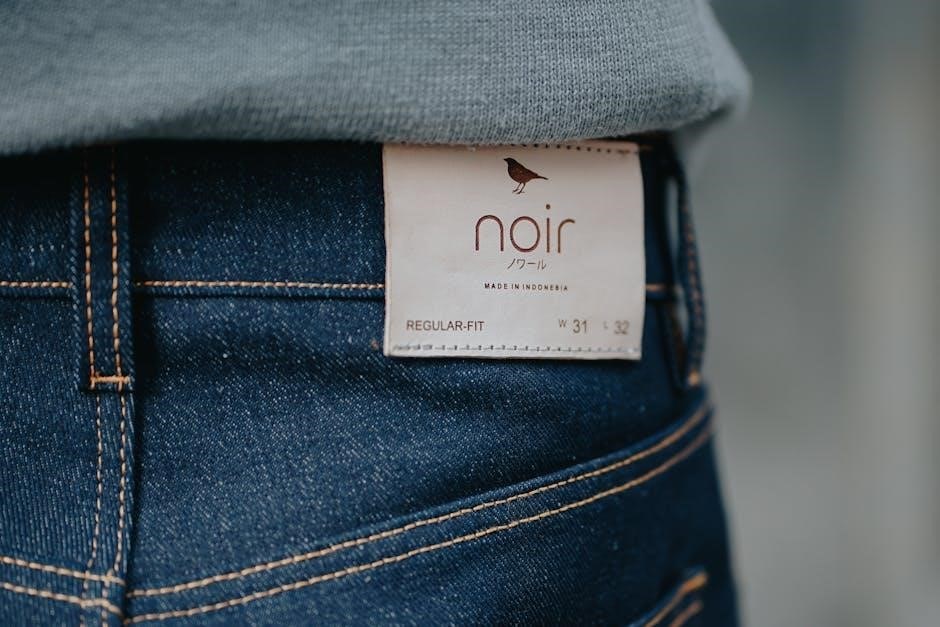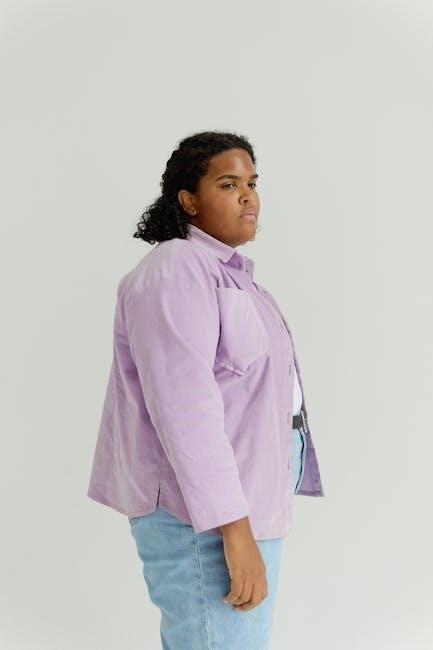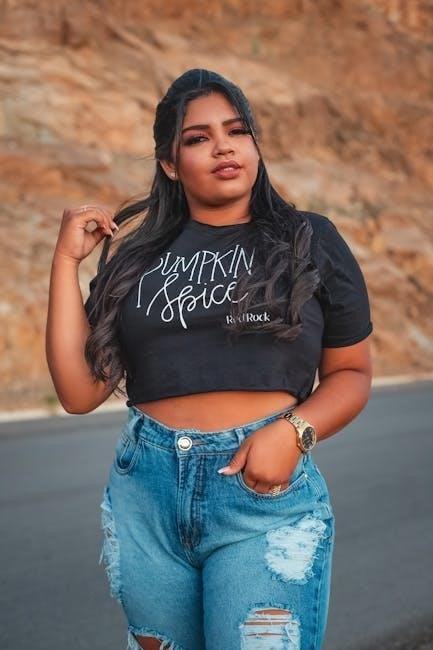Understanding Denim Sizing
Denim sizing focuses on waist and inseam measurements, differing from regular clothing. Sizes can vary due to fabric stretch and shrinkage, making standardization challenging across brands and styles.

The Difference Between Denim and Regular Clothing Sizing
Denim sizing focuses on waist and inseam measurements, unlike regular clothing, which often uses chest, waist, and hip measurements. Denim sizes can vary due to fabric stretch, shrinkage, and style, making standardization challenging across brands and fits.
Key Measurements: Waist, Hips, and Inseam
Waist, hips, and inseam are the primary measurements for denim sizing. The waist measures the narrowest point of your natural waistline, while the hips are measured around the fullest part, typically 7-9 inches below the waist. The inseam, or inner leg length, determines the pant leg’s length. Accurate measurements ensure the best fit, as denim sizes can vary between brands and styles due to fabric stretch and shrinkage.
How to Measure Yourself for Denim
Measure your natural waistline and hip circumference firmly. Measure inseam from crotch to ankle bone. Ensure accurate measurements for the best denim fit.
Step-by-Step Guide to Measuring Waist, Hips, and Inseam
Waist: Measure around the narrowest part of your natural waistline, keeping the tape horizontal.
Hips: Measure around the widest part of your hips, approximately 7-9 inches below your waistline.
Inseam: Measure from the base of your crotch to the bottom of your ankle.
Use a flexible tape measure and ensure the tape is level for accurate results. For inseam, reference a pair of well-fitting jeans.

Importance of Accurate Measurements
Accurate measurements ensure the best fit, comfort, and style for your denim. Incorrect measurements can lead to jeans being too tight or too loose, affecting both comfort and appearance. Proper sizing also prevents issues like gapping at the waist or restrictive movement. Since denim sizes vary across brands, precise measurements help you navigate size charts effectively and find your perfect fit every time.
Denim Fit Guide
Denim fit varies from skinny to loose, catering to different body types. Each style ensures comfort and style, helping you choose the perfect fit for your physique.
Types of Fits: Skinny, Slim, Straight, and Loose
Different denim fits cater to various preferences and body types. Skinny jeans offer a tight, form-fitting look, while slim-fit styles provide a slightly looser yet still streamlined appearance. Straight-leg jeans maintain a consistent width from thigh to ankle, offering a classic, timeless style. Loose-fit options are designed for comfort, with a relaxed silhouette that allows for ease of movement and a casual look. Each fit ensures a flattering and comfortable choice, allowing individuals to select the style that best suits their lifestyle and personal taste.
Choosing the Right Fit for Your Body Type
Your body type plays a crucial role in selecting the perfect denim fit. Petite frames often look best in slim or straight-leg styles, while taller individuals can opt for loose or boyfriend fits. Hourglass figures benefit from high-waisted skinny jeans, accentuating curves. Pear-shaped bodies find balance in boyfriend or loose fits, while rectangular body types can add shape with flared or bootcut styles. Understanding your silhouette helps in making flattering choices.
Denim Size Charts
Denim size charts provide standardized measurements for waist and inseam, helping you navigate sizing variations across brands and styles effectively.
Universal Size Chart for Women and Men
A universal size chart standardizes denim sizing, offering consistent measurements for both genders. It typically includes waist and inseam dimensions, converting US, EU, and UK sizes. For example, a 28-inch waist corresponds to US size 6, EU 34, and UK 8. This chart helps bridge sizing differences across regions, ensuring a more accurate fit. Measurements are usually provided in inches or centimeters, aiding consumers in making informed purchases.
How to Read and Use Size Charts Effectively
To effectively use denim size charts, start by measuring your waist, hips, and inseam accurately. Compare these measurements to the chart, ensuring alignment with your body type. Pay attention to fabric stretch, as this affects fit. Consider the style—skinny, slim, or loose—to match your preferences. Double-check international conversions if needed and refer to brand-specific guides for precise sizing. This approach ensures a tailored fit and reduces sizing errors.
International Size Conversions
This section helps convert denim sizes between US, EU, and UK standards, ensuring a perfect fit. It also explains abbreviations like W/L for better understanding.
Converting Between US, EU, UK, and Other Sizes
Denim size conversions vary across regions, with US, EU, and UK sizes differing significantly; For example, a US size 6 often corresponds to an EU size 34 and a UK size 8. Understanding these conversions ensures a proper fit when shopping internationally. Always refer to a detailed size chart to avoid discrepancies, as brands may slightly vary in their sizing standards.
Measurements are typically provided in inches or centimeters, focusing on waist and inseam. Use these to align with your region’s sizing system. Accurate conversions help in selecting the perfect fit, avoiding returns or alterations.
Understanding W/L and Other Abbreviations
Denim abbreviations like W/L (Waist/Length) are essential for sizing. W/L indicates the waist size in inches and the inseam length. For example, W32/L34 means a 32-inch waist and 34-inch inseam. Other abbreviations include S, M, L for fits and terms like “Relaxed” or “Slim” describing styles. Understanding these codes helps in selecting the ideal jeans, ensuring comfort and style alignment with your body type and preferences.

Finding Your Perfect Fit
Finding your perfect fit involves accurate measurements, understanding your body type, and considering fabric stretch. Experiment with styles like skinny, slim, or straight to ensure comfort and confidence.
Tips for Selecting the Ideal Jeans Style and Size
Start by measuring your waist, hips, and inseam accurately. Consider your body type—curvier figures may prefer high-waisted styles, while petite frames suit cropped lengths. Choose between skinny, slim, straight, or loose fits based on comfort and personal style. Fabric matters; stretch denim offers flexibility, while rigid styles provide structure. Experiment with sizes and styles to find the perfect balance of fit and confidence.
The Role of Stretch and Fabric in Fit
Fabric composition significantly impacts denim fit. Stretch denim offers flexibility, hugging the body for a comfortable, flattering silhouette. Rigid fabrics provide structure, ideal for those seeking traditional jeans. Tencel blends enhance softness and durability, while cotton dominates for classic styles. Understanding fabric types helps tailor choices to personal preferences and body types, ensuring optimal comfort and aesthetic appeal in every pair.

Brand-Specific Denim Size Guides
Brands like Madewell and Levi’s provide detailed size charts, ensuring accurate fits. Each brand tailors sizes to specific styles, making it essential to consult their guides for best results.
Madewell, Levi’s, and Other Popular Brands
Madewell and Levi’s offer detailed denim size charts, ensuring precise fits. These brands provide measurements for waist, hips, and inseam, catering to diverse body types. Madewell’s guide includes universal sizing, while Levi’s focuses on both men’s and women’s fits. Other brands like ASOS and Hudson also offer tailored size guides, helping customers find their perfect match. Always check specific brand charts for accurate sizing.
How Brand Sizes Can Vary
Denim sizes differ significantly across brands due to unique fits, fabrics, and measurement standards. For instance, Madewell may offer a more tailored fit, while Levi’s could provide a relaxed style. Some brands use stretch fabrics, altering how sizes fit. Always consult specific brand charts, as variations in waist and inseam measurements can impact the overall fit and comfort of your jeans.

Denim Care and Maintenance
Washing and shrinking can alter denim fit. To preserve shape, wash jeans inside out and avoid soaking. Proper care extends fabric life and maintains optimal fit and quality.
How Washing and Shrinking Affect Fit
Washing and shrinking can significantly impact denim fit. Hot water causes fabric to shrink, tightening the waist and inseam. Excessive washing may lead to fading and loss of elasticity. To preserve fit, wash jeans inside out in cold water and avoid over-drying. Some brands treat denim to minimize shrinkage, ensuring a consistent fit over time. Proper care helps maintain shape and comfort.
Best Practices for Caring for Your Jeans
To maintain your jeans’ fit and quality, wash them inside out in cold water and avoid over-drying. Steaming is preferable to ironing to prevent stretching. Use mild detergents and avoid harsh chemicals. Washing sparingly preserves the fabric’s integrity and color. Proper care extends the life of your jeans, ensuring a consistent fit and comfort over time.

Troubleshooting Common Fit Issues
Troubleshooting fit issues starts with assessing how jeans feel when worn. If too tight, consider a larger size; too loose, opt for a slimmer style. Shrinkage can affect fit. If persistent, explore different styles or sizes for optimal comfort and appearance.
What to Do If Your Jeans Are Too Tight or Too Loose
If your jeans are too tight, consider a larger size or a style with stretch fabric for comfort. Too loose? Opt for a slimmer fit or adjust with a belt. Shrinkage can cause tightness after washing, while excessively loose jeans may require tailoring. If issues persist, explore different sizes or styles to ensure the best fit for your body type and desired comfort level.

When to Consider Different Sizes or Styles
If your jeans are consistently too tight or too loose, it may be time to explore different sizes or styles; Consider your body type and personal comfort preferences. Slim or straight fits suit lean builds, while loose or relaxed styles are ideal for broader frames. Always refer to size charts and brand-specific guides to ensure the best fit and comfort for your unique measurements and lifestyle needs.
